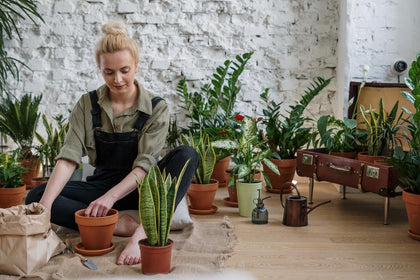True self-care should be viewed as more than an occasional spa day or taking the chance to treat yourself. Instead, it should be an effort to incorporate wellness into all parts of your life, to support your physical and mental health by creating an environment where you thrive — especially in your home. And plants can be part of that effort.
Just having a few green and growing things around, even impossible- to-kill air plants or hardy succulents, provides a huge boost to your autonomic nervous system, activity and creativity levels and general mental health. Here's a closer look at the benefits of bringing greenery into your interior spaces, and why introducing a few plants into your space might be the perfect tool for practicing self-care.
The Magic of Fresh Air
It's no secret that spending time outdoors is good for your body and mind. Breathing in the fresh air and being surrounded by plants is one of the quickest routes to lowering stress levels and increasing your well-being.
According to David and Austin Perlmutter, co-authors of "Brainwash: Detox Your Mind for Clearer Thinking, Deeper Relationships, and Lasting Happiness," nature is the original source of wellness. Spending time outdoors can have a profound impact on your quality of life, lowering your heart rate and helping clear the toxins from your system — as well as improving your mood.
As the Perlmutters put it, "Nature influences our ability to experience balance, thoughtfulness, and compassion while providing a panoply of health benefits, including reduced inflammation and stress hormones." In fact, they argue that green spaces can actually help rewire the brain for better health, improved focus and lasting satisfaction.
The research is clear: Simply heading outside for a daily walk has a significant impact on your quality of life. It gives us an opportunity to breathe in the fresh air of the outdoors, heightening the oxygen levels in our blood and strengthening our physical health. In their book, the Perlmutters break down some of the scientifically studied benefits of spending time in nature, which include:
- Boosted immune system functioning, with an increase in count and activity of the body's natural killer cells
- Reduced blood pressure
- Heightened coping abilities for stress and less stress in general
- Improved moods
- Increased mindfulness
- Increased ability to focus
- Accelerated recovery from surgery or injury
- Increased energy
- Improved sleep
To put it simply, the benefits of plants in the outside world are abundant, so why not cultivate some of that goodness indoors?
Also: How to Challenge Yourself to a Month of Vegan Eating
Bringing the Outdoors In
So what happens when you bring plants indoors? Can they have as much impact on your well-being as the plants outside your home? Studies show that introducing plants into your home is one of the best things you can do for your quality of life. The benefits of houseplants are as clear as the benefits of the great outdoors, and researchers have discovered a host of benefits associated with the practice of keeping indoor plants in homes.
For starters, there's evidence that plants can improve indoor air quality. Leafy foliage plants are especially effective at increasing the level of oxygen in built spaces, as their leaves suck up excess carbon dioxide and help regulate the room's humidity by circulating water through their roots.
Houseplants have been linked to a decrease in the outbreaks of "sick building syndrome," where people complained about the side effects of working in newly built spaces, absorbing the toxins released by off-gassing construction materials. Large numbers of indoor plants have also been found to help balance humidity in shared spaces while suppressing mold spores and other airborne microbes that may occur when using a humidifier.
Studies also suggest that having adding a plant or even a representation of nature to a sick room can dramatically increase patient healing rates and reduce the use of pain medication. As the Perlmutters state, "A simple potted plant can significantly change hospital outcomes." Patients who are exposed to greenery of any kind in their environment, including something as simple as a vase full of cut flowers in water, tend to have much better health outcomes than those who are in rooms without flowers or plants. It doesn't even have to be a living plant! Researchers have found that even an image of a plant, or a view out the window into a place where plants grow, can positively impact recovery time.
Furthermore, as the Perlmutters write in Brainwash, having indoor plants in your workspace can vastly improve worker productivity and the well-being of employees. In a number of studies, they explain, "Natural elements in the workplace served as predictors of overall better health (e.g., lower depression and anxiety) as well as job satisfaction." The research shows that the benefits of plants in the workplace are extensive. With so many of us working from home these days, houseplants are a critical tool for improving health outcomes and work performance.
How To Bring Houseplants Into Your Home
So you're sold on the power of houseplant — what now? Whether you have a green thumb or a brown one, there are many easy ways to incorporate plants into your home.
One of the easiest and cheapest ways to bring a little plant magic into your living space is to practice water propagation, which requires nothing more than water, air, light, and a little time. On a walk through your neighborhood, or when visiting a plant-loving friend, collect easy-to-sprout leaves, like ivy, and place them in a glass of water. Over time, you can watch as the leaves sprout little roots, slowly growing strong enough to transplant into the earth. The trendy spider plant responds particularly well to this method of plant care, sucking up carbon dioxide as it sprouts, filling the air with increased oxygen levels.
If you're ready to go to the nursery, succulents are a perfect starter plant. Demanding little attention, they're the perfect plants for those of us who have more goodwill than experience when it comes to keeping plants alive. And once you've mastered the art of keeping a succulent alive, there's a whole world of plant life to explore.
Also: What You Should Know About Stress and Hair Loss
Houseplants and Self-Care
Whatever plants you chose to surround yourself with, there's a growing body of evidence that having plants around helps encourage good mental health. Sometimes it can be hard to find the time and energy to venture into the outside world, but if you have plants in your space, you automatically have a reminder of your connection to nature, gaining an effortless dose of the benefits plants bring.
Beyond the simple pleasures of their presence, having plants around encourages you to create a routine where you're able to care for something outside yourself. This helps motivate positive behaviors, like staying hydrated (a drink for you and one for your plants) and moving your body as you check in on those plants — a simple activity that can help dramatically reduce your stress levels.
And with reduced stress levels linked to everything from increased wellness to improved hair health, keeping plants around might not only be the key to self-care, but it might also be your best-kept beauty secret! Whatever your self-care routine, plants can provide an invaluable opportunity to check in with yourself and be reminded of the healing power of nature.
More From VEGAMOUR
- 8 Yoga Poses for Hair Growth
- How Inflammation Affects Your Hair
- 16 Best Foods for Hair Growth
- Does Lack of Sleep Cause Hair Loss?
Photo credit: cottonbro/Pexels



















